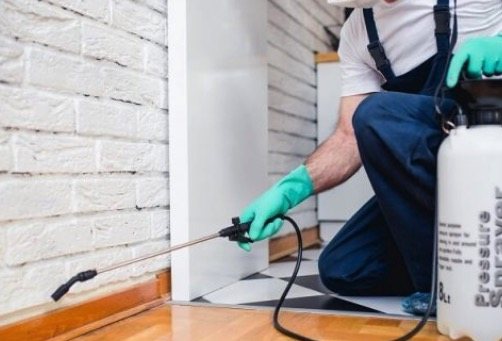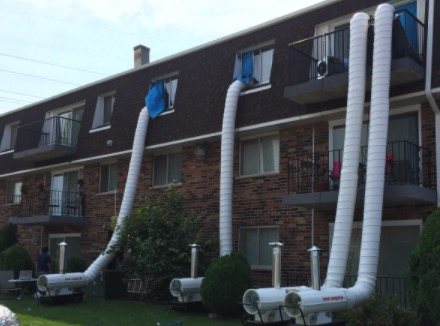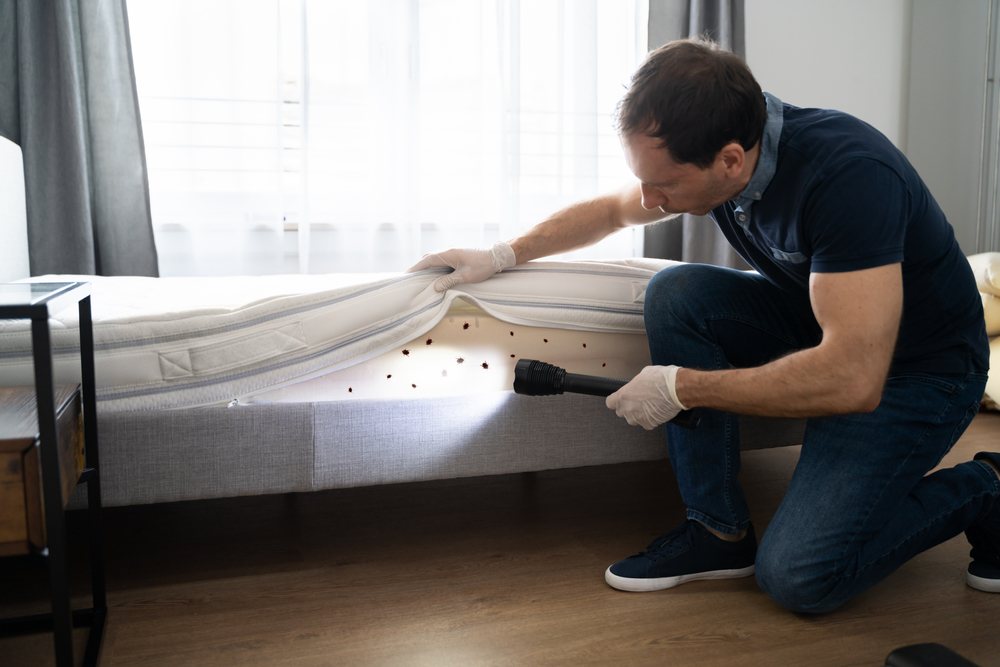In the early 20th-century bed bugs were incredibly common, and people routinely checked for them before going to sleep.
This is why for decades, bed bugs existed as a nursery rhyme that our parents told us before bed.
Now they have made an unfortunate return…
with infestations reported in cities across America.
A serious infestation can turn somebody’s life upside down.
Those who have fallen victim to bed bugs know that they need to be taken seriously.

As the global population continues to rise, and traveling increases, bed bugs have more opportunity to spread.
There is little to show that these insects are going away anytime soon.
Bed bug signs are challenging to spot, and most people don’t know they have an infestation until it’s too late.
So on that dark note… let’s dive in.
Page Contents:
What Caused the Global Decline in Bed Bugs?
In developed countries, bed bug infestations decreased throughout the end of the 20th century because of the breakthrough technology of insecticides.
Improvements in personal hygiene also played a factor in the reduction of reported bed bug cases.
During the mid-1950s to the late 1990s bed bugs largely disappeared. They became so rare that they also disappeared from people’s minds.

The precaution and preventive measures that people used to take against bed bugs fell away as well…
Leaving us vulnerable.
Bed bugs actually became so rare that people could no longer identify them against similar insects. Even worse, is that the new generation of pest control professionals were no longer equipped to fight them, according to Roberto Pereira, a University of Florida research specialist.
So like many other epidemics, bed bugs were largely eradicated…
Which brings up the question…
How did bed bugs return?
What is Causing the Current Bed Bug Epidemic
The bed bug resurgence is due to 2 main developments:
Change in Insecticide Regulation:
In the mid-1970s, certain organophosphates such as DDT, were banned with the introduction of less toxic alternatives. These new treatment options were less effective and did not persist to the degree necessary to kill these insects.

At the same time, bed bugs will retreat to cracks/crevices in walls and the new treatment methods could not reach these areas effectively.
Increased Travel:
Despite the decline that occurred in infestations in the developed world during the mid 20th century, bed bugs did not disappear in less developed countries, but actually quite the contrary….
Bed bugs thrived.
Bed bugs are particularly adept at hitchhiking on humans, whether it be in their clothes, belongings, or on their bodies.

People then brought bed bugs back to the more inviting environment in developed countries in the early 2000s, bringing them back to areas where they were previously eradicated.
Can Bed Bugs Come Back After a Year?
It’s extremely frustrating when you treat your home only to have bed bugs return, even after a year or longer of being bed bug free.
The fact is bed bugs are tricky pests, and you can pick them up from anywhere.
Here are a few reasons why bed bugs could return after you thought the infestation was behind you.
1. The dangers of DIY treatment
If you decide to treat an infestation yourself.
(We get it, professional treatments can be expensive.
You run a great risk of re-infestation.
If the infestation was small or in a cornered location, DIY methods do sometimes work, but often they don’t fully remove the infestation.
In fact, even if one female bed bug is left behind reoccurrence is likely.
2. Professional Treatment Done Incorrectly
Even the pros sometimes mess up, and the infestation wasn’t fully treated. Or the customer only has the exterminator treat certain rooms in an effort to try and save money.

A single female can lay up to 200 eggs in her lifetime, so if even one-bed bug is missed, the infestation can come back in a matter of months (or years in some cases).
3. An Adjacent Apartment Wasn’t Treated
Even if you did all the right things, that doesn’t mean you’re immune to an infestation.
Let’s say you took the following steps to remove bed bugs:
- Reported the infestation to your landlord in a timely manner.
- Coordinated with property management related to bed bug treatment.
- Prepared your residence for treatment and vacated the premises appropriately.
- The treatment was applied and you settle back into your apartment.
Yet after all this, bed bugs still came back?
This is likely due to your neighbors being infested, causing bed bugs to spread back to your apartment.

Bed bugs can travel through walls and re-enter your residence at any time.
4. The Temperature Drops
Bed bugs react to temperature because they’re cold-blooded, so when the temperature drops these creatures enter a dormant state.
This state slows down their metabolism and allows them to conserve energy until conditions are more favorable.
When in this state, it’s pretty similar to mammal hibernation. They do not need to feed and can survive up to 6 months without a meal.
If they’re caught in a particularly cold environment (below 55 degrees Fahrenheit) bed bugs can survive up to a year.
At the end of the day, bed bugs don’t spread quickly, but they reproduce efficiently and come to feed at the right time.
Therefore, even if you have been bed bug free for a full year…
You’re not immune to another infestation.
Bed Bugs Keep Coming Back (What do I do)?
If you’re in a situation where you already had a professional treat your home for bed bugs, you should reevaluate the treatment that occurred and ask yourself the following questions:
Was the treatment done by a certified pest control specialist? If so, what method did they use?
Was the treatment applied to the whole apartment? Or only certain rooms?
If I live in a multi-unit complex, are my neighbors infested with bed bugs?
Unfortunately, your only option is to have professionals come back and apply another treatment.
If originally you used conventional treatment methods or a DIY treatment, consider looking into the bed bug heat treatment.
How Successful is Heat Treatment for Bed Bugs?
The heat treatment is a relatively newer strategy used by pest control companies to eradicate an infestation.
These services involve heating an entire home to at least 130 degrees Fahrenheit, which bed bugs cannot survive in for more than a few hours.
A heat trailer is positioned outside the home to provide power, and fans are placed in each room to apply heat evenly across multiple rooms.
Heat Treatment Benefits
- This is a more natural process of killing bed bugs. There are no leftover chemicals or residual gasses that can harm you or your pets.
- Heat treatments will kill bed bugs in hours, rather than weeks.
- A heat treatment requires one visit, whereas chemicals may require multiple follow up visits.

Heat treatments kill bed bugs in all life stages, (eggs, nymphs, adults) and treats the entire living area along with everything inside.
Prevent a Future infestation
When after a long drawn out fight, you have finally rid yourself of bed bugs you will want to take the necessary precaution to prevent another infestation.
While mounting evidence suggests that travel is the greatest way humans are exposed to bed bugs, you don’t have to be afraid and swear off traveling.
Instead, while traveling, you should inspect your hotel room or Airbnb for signs of an infestation.
(Even before unpacking).
You might even go as far as putting your luggage in the bathroom where bed bugs are less likely to go.
Make sure to inspect the mattress and headboard, and turn down the sheets, looking for any blood stains or feces.

Closets and drawers should also be inspected with a flashlight before putting clothes in them.
Before you travel home, put all of your clothes in a plastic bag and immediately wash/dry on high heat.
If you do find bed bugs in your suitcase, those items should be scrubbed with boiling hot water, or just thrown out entirely.
Consider purchasing bed bug proof luggage liners, laundry, bags, or mattress encasements to help prevent further infestation.
How Long After Bed Bug Treatment Can I Return Home?
It’s important that you accommodate pest control professionals by leaving your home when they begin treatment. Exterminators need space to set up equipment and should be able to operate without distraction.
The length of which you need to be away from your home depends on the treatment.

If you undergo a heat treatment, you can likely return home at the end of the day.
If you undergo a major insecticide treatment you may have to vacate the premises for 2 -3 days.
(Though it depends on the type of insecticide being used).
Bed Bug Outbreak in 2021?
The Coronavirus pandemic has greatly curtailed the existence of bed bugs that had been ravaging Americans. Since fewer people are traveling, leading to reductions in nightly stays at hotels, motels, and other venues, the chances of being bitten are smaller than in previous years.
Though this is not a license to be complacent, as these bed bugs continue to survive. A recent study found that bed bugs have been around since the dinosaurs walked the earth.
It’s staggering to learn how much bed bugs have grown in a couple of decades. In the top 50 cities the number of bed bug cases rose, leading to more and more bed bug lawsuits being filed against landlords, hotel management, and property owners.

According to New York’s City Council, annual complaints about bed bugs from 2004 to 2009 rose from 537 to 10,985.
This rise in numbers has prompted some states to pass bed bug laws and prompt restrictions on things like discarding mattresses on an alley or sidewalk.
Here is another staggering statistic:
Worldwide professional exterminators have reported that the number of infestations increased by more than 4,500% since the early 2000s.
Though 2021 may be an easier year for bed bugs due to the COVID-19 pandemic….
These creatures certainly aren’t going away any time soon.
Talk to a Lawyer
If you were bitten by bed bugs in a hotel room, apartment, Airbnb, or assisted living facility, you may be able to receive compensation for your losses.
In many states, property owners have a duty to deliver and maintain a clean/safe living environment for their dwellers.
You have the potential to receive compensation for any of the following monetary and non-monetary losses:
- Physical Injury
- Pain & Suffering
- Lost Wages
- Damaged Belongings
We can connect you with a licensed attorney in your state to discuss your specific situation and help determine whether you have a case. For a FREE (no obligation) consultation, get in touch with us today!






SO SCARY! I hate bugs in general but bed bugs are extra frightening. Just the thought of them crawling around my bedroom sounds horrible! I appreciated the advice on how to prevent bed bugs… I just hope the world figures out a way to get rid of them soon.
My mother had bedbugs. I was the fortunate one to clean out her apartment when she moved. Since the bugs were limited to the living room most of her stuff was clean. The kitchenware was good (pots pans/dishes sliverware). I realized I had left boxes there months earlier and when I brought all her packed stuff to my house I did see a couple bugs. I only saw 2 in about a year. The boxes are stored in my basement for over two years now. it’s not freezing down there as it’s a 20×20 basement with 5.5′ ceilings, is pretty much packed with my own stuff so it stays pretty warm (50’s-60’s) with the furnace running 20-25xday in winter. I have never had bugs upstairs.
So my question is… is it safe to say any stoaway bugs are dead now? You say they can live up to a year but it’s been 2.5 yrs now. there are a few things I would like to bring upstairs but want to make sure. One is a grandfather clock (cheap one, nothing fancy) that is cheap composite board.
Thanks so much.
This was one of the best articles I’ve read. In the timeframe I grew up, I didn’t even know they actually really existed. I learned a lot from this post. Thank you!